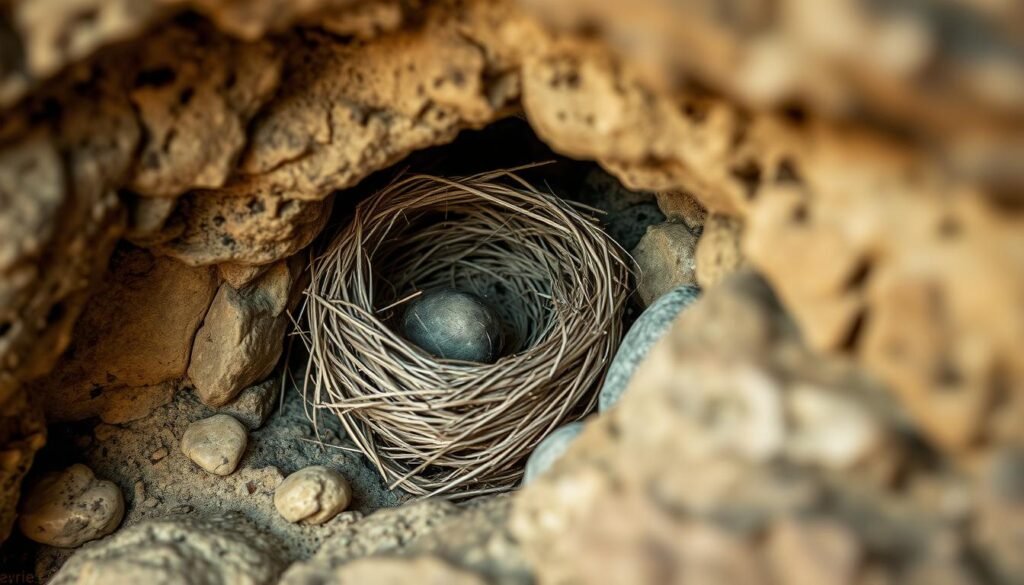Swiftlet farming is a booming business. Using nest boosting hormone is key to attracting swiftlets. The aim is to draw birds and get them to build nests. This can be done with the right hormone techniques.
By mastering nest boosting hormone, farmers can lure more swiftlets. This leads to more nests, which is vital for success in swiftlet farming. With the right methods, you can see a big jump in nest construction and profits.
Key Takeaways
- Using nest boosting hormone can increase swiftlet attraction
- Effective hormone techniques are crucial for successful swiftlet farming
- MDK Nest boosting hormone is a popular choice among farmers
- Luring birds with the right techniques can boost nest construction
- Nest boosting hormone can lead to higher profits in swiftlet farming
- Understanding how to use nest boosting hormone is essential for farmers
Understanding Swiftlet Behavior and Nesting Patterns
Swiftlets are drawn to certain smells and pheromones. These are key in their mating and nesting. The bird nest is vital to them, and knowing what attracts them is crucial. A specific aroma linked to their mating liquid is a major attractant.
To encourage swiftlet nesting, farmers use various methods. They employ a certain aroma and mimic natural bird nest sites. The hormone is diluted 1:3 with water, then sprayed and allowed to evaporate naturally or with a fan and bubbler.

- Nesting site selection: Swiftlets prefer safe, secure locations for their nests.
- Pheromones: Specific pheromones, like the mating liquid, draw swiftlets to certain sites.
- Aroma: A particular aroma is also crucial in attracting swiftlets.
By grasping these factors, farmers can better attract swiftlets. Techniques like hormone application make nesting sites more appealing.
| Factor | Description |
|---|---|
| Nesting site selection | Swiftlets are attracted to specific locations that provide a safe and secure environment for their nests. |
| Pheromones | The use of specific pheromones, such as the mating liquid, can help attract swiftlets to a particular nesting site. |
| Aroma | The presence of a specific aroma can also play a crucial role in attracting swiftlets to a nesting site. |
Introduction to Nest Boosting Hormones
Nest boosting hormones are key in swiftlet farming. They make swiftlets want to nest and have babies. These hormones act like the natural scents swiftlets use to find each other.
By adding these hormones, farmers make their farms more appealing to swiftlets. This helps the birds to nest and have babies. This is crucial for the success of swiftlet farming.
One big plus of nest boosting hormones is they help birds mate. This is especially helpful when many birds are around but not nesting. It’s a big challenge in swiftlet farming to get birds to nest and have babies.
But with nest boosting hormones, farmers can make their farms better for nesting and having babies. This can really help their swiftlet farming do well.
Some important things about nest boosting hormones are:
- They mimic the natural pheromones that swiftlets produce
- They create an environment that is attractive to swiftlets
- They can encourage birds to mate and nest
Nest boosting hormones are made just for swiftlets. They are a big help in swiftlet farming. They make it easier for swiftlets to nest and have babies.
By using these hormones, farmers can make their farms great for nesting and having babies. This can really help their swiftlet farming succeed.

Nest boosting hormones are very useful in swiftlet farming. They help farmers make their farms better for nesting and having babies. By understanding how these hormones work, farmers can make their farms the best they can be for swiftlets.
The Science Behind Using Hormone to Attract and Lure Swiftlet
To lure birds like the burung walet, knowing the science of hormone use is key. The area where you spray hormones should have birds already. This method can draw more swiftlets, boosting nesting success.
Chemical Composition
The hormones’ chemical makeup is complex and crucial. Knowing this helps farmers decide how to use them. It’s all about attracting birds, like the burung walet, to their area.
Behavioral Response Mechanisms
How birds react to these hormones matters a lot. Understanding this helps farmers lure birds more effectively. It increases the chances of successful nesting.
Environmental Impact Considerations
Using hormones to lure birds must consider the environment. Farmers should use them responsibly. This way, they can protect the environment while luring birds.
MDK Nest Boosting Hormone: A Market Leader
In swiftlet farming, a good nest boosting hormone is key. It attracts swiftlets and helps them build nests. MDK Nest Boosting Hormone is a top choice, known for its success and many happy customers.
Using MDK Nest Boosting Hormone offers several benefits:
- It’s very good at drawing in swiftlets.
- It encourages nest building, which means more productivity.
- It’s simple to use and apply.
MDK Nest Boosting Hormone is the top seller in Shopee Malaysia. Its success is well-documented, making it a favorite among swiftlet farming fans.
In swiftlet farming, a reliable nest boosting hormone is essential. With MDK Nest Boosting Hormone, farmers can count on a quality product to help them succeed.
| Product | Effectiveness | Customer Satisfaction |
|---|---|---|
| MDK Nest Boosting Hormone | Highly Effective | Excellent |
Proper Application Techniques for Maximum Results
To get the most out of nest boosting hormones, it’s key to apply them right. This means following dilution guidelines, using the right spray methods, and knowing when and how often to apply. By doing this, farmers can use the hormones safely and effectively. This boosts their chances of attracting swiftlets and increasing bird nest construction.
To apply, mix the hormone with water at a 1:3 ratio. Then, let it dry naturally or use a mini fan and bubbling machine. This method releases a scent that attracts swiftlets to the nesting area.
Dilution Guidelines
It’s important to stick to the recommended dilution ratio. A 1:3 mix is best. It ensures the hormone works well and is safe for the swiftlets.
Timing and Frequency
When and how often you apply the hormone matters a lot. Use it during the breeding season and at times that match the swiftlets’ natural cycle.
Spray Methods
The way you spray the hormone affects its success. A fine mist is best. It spreads the hormone evenly across the nesting area.
- Use a spray bottle to apply the hormone
- Spray the hormone in a fine mist
- Allow the hormone to evaporate naturally or with a mini fan and bubbling machine
By using these application techniques, farmers can make the most of the nest boosting hormone. This increases their chances of attracting swiftlets and boosting bird nest construction.
Strategic Placement and Coverage Areas
Using nest boosting hormones to lure birds, like the burung walet, needs careful planning. The area where you spray the hormones should have nests. This way, birds can smell it and might build more nests.
To get the most out of nest boosting hormones, think about these points:
- Existing nest sites: Spray the hormones in areas where there are already nests to attract more birds.
- Coverage area: Ensure the hormones are applied evenly throughout the designated area to create a consistent aroma.
- Timing: Apply the hormones at the right time to coincide with the birds’ nesting season.
By placing and covering the area with nest boosting hormones wisely, farmers can draw more burung walet and other lure birds. This can greatly increase nest building and help the farm succeed.
Optimizing Environmental Conditions
Swiftlet farming needs a good understanding of the birds’ needs. Farmers must control temperature, humidity, and air flow. This creates a great place for swiftlets to nest and have babies. Using nest boosting hormone helps too, especially where many birds are but not nesting.
Keeping the temperature between 24-27°C is key. This lets the birds do well and nest. Humidity should be 70-90% to match their natural home. Good air flow is also important to avoid bad smells and gases.
Temperature Control
Keeping the right temperature is crucial. A range of 24-27°C is best for nesting and baby birds. Farmers use insulation, air flow, and heating or cooling to keep this temperature.
Humidity Levels
Humidity is also very important. It should be 70-90% to keep the birds healthy and nesting. Farmers use humidifiers or misting systems to keep the humidity just right.
Ventilation Requirements
Good air flow is vital to stop bad smells and gases. Swiftlet houses need enough air flow to keep air clean and encourage nesting. Nest boosting hormone also helps attract more birds, making nesting and baby birds more likely.
Success Stories Across Southeast Asia
MDK Nest boosting hormone has shown great results in countries like Malaysia, Thailand, Indonesia, Vietnam, Cambodia, and Myanmar. By looking at case studies and data, farmers can see how these hormones work. They can also learn how to use them to attract swiftlets and boost bird nest construction.
The hormone makes the aroma that attracts swiftlets better. This leads to more mating liquid and more bird nests. Farmers in the region have seen big economic gains because of this.
Some notable success stories include:
- Increased bird nest production in Malaysia by 25%
- Improved aroma attractiveness in Thailand, resulting in a 30% increase in swiftlet population
- Enhanced mating liquid production in Indonesia, leading to a 20% increase in bird nest construction
These stories show how MDK Nest boosting hormone works in different places. It can increase bird nest production and aroma attractiveness. This leads to more mating liquid and economic benefits for farmers.
| Country | Increase in Bird Nest Production | Improvement in Aroma Attractiveness | Enhancement in Mating Liquid Production |
|---|---|---|---|
| Malaysia | 25% | 15% | 10% |
| Thailand | 20% | 30% | 15% |
| Indonesia | 15% | 20% | 20% |
Troubleshooting Common Issues
Using nest boosting hormones to lure birds, like the burung walet, can face some common problems. These might be about how you apply the hormones, where you put them, or the weather. Finding out what’s wrong helps farmers fix it and make the hormones work better.
Here are some common problems and how to solve them:
- Incorrect application method: Adjust the dilution guidelines or spray methods to ensure the hormones are applied effectively.
- Inadequate placement and coverage: Change the placement and coverage areas to ensure the hormones are reaching the target area.
- Suboptimal environmental conditions: Optimize the temperature, humidity, and ventilation to create a conducive environment for the burung walet to nest.
By fixing these common issues, farmers can make the nest boosting hormones more effective. This helps in
Monitoring and Measuring Success
In swiftlet farming, it’s key to watch and measure how well things are going. This helps farmers see how nest boosting hormone affects swiftlet behavior and nesting. By looking at important signs, farmers can learn a lot.
Here are some things farmers should keep an eye on:
- How many swiftlets come to the nesting site
- How many nests are built in a certain time
- The health and happiness of the swiftlets
By keeping records and using tools to track progress, farmers can spot what needs work. They can then make smart choices to better their swiftlet farming setup. This might mean changing how often or how much nest boosting hormone they use.
It’s important to keep checking and reviewing how things are going. This helps farmers keep their swiftlet farming on track for the long haul. By being flexible and adjusting to new info, farmers can keep their swiftlets healthy and happy.
| Performance Indicator | Target Value | Actual Value |
|---|---|---|
| Number of swiftlets attracted | 100 | 120 |
| Number of nests constructed | 50 | 60 |
| Swiftlet population health | 90% | 95% |
Conclusion
Using nest boosting bird nest hormones can change the game for swiftlet farmers. It helps attract and increase nest construction. By understanding these specialized aromas and using them well, farmers can boost their productivity and profits.
The mating liquid formulas mentioned in this article work great. They make swiftlets build more nests and do well in their homes. With the right methods and the best conditions, farmers can improve their swiftlet yields and stay competitive.
It’s important to use nest boosting in a smart, data-driven way. Keep track of progress, solve problems, and always improve your methods. By being informed and flexible, swiftlet farmers can use these hormone-based technologies to their fullest. This will help them lead in the bird nest production world.
FAQ
What is the best-selling nest boosting hormone?
MDK Nest boosting hormone is the top choice. It has many positive reviews for its results. Sales data shows it’s a hit in Shopee Malaysia.
How do I properly apply nest boosting hormones?
To apply, mix the hormone with water at a 1:3 ratio. Spray it and let it dry naturally or use a fan and bubbling machine.
Where should I apply the nest boosting hormone?
Spray it where nests already exist. This way, birds can smell it and be attracted.
How do nest boosting hormones encourage swiftlets to mate?
MDK Nest boosting hormone helps birds mate. It’s especially useful when many birds are present but not nesting.
In which countries has MDK Nest boosting hormone been proven effective?
It works well in Malaysia, Thailand, Indonesia, Vietnam, Cambodia, and Myanmar.
What are some common issues that may arise when using nest boosting hormones?
Several issues can happen with nest boosting hormones. Troubleshooting helps find and fix problems.
How can I monitor and measure the success of using nest boosting hormones?
It’s key to track how well nest boosting hormones work. Use performance indicators, document methods, and track progress. This helps understand and improve results.




